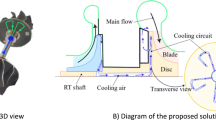Abstract
The paper is devoted to the matter of energy losses prediction in axial turbine cascade based on CFD analysis. An intensive development of numerical modelling of flows in turbomachinery and the advent of various turbulence models open up major opportunities for blade row gas-dynamic efficiency estimation. Nowadays statistically significant data on the difference between predicted and experimental losses for flow conditions with Mach number near 1 and above are not available in public domain. Therefore the present paper offers analysis results for several turbine blade cascades of various geometries, that have detailed experimental data. Reynold’s stress model in CFD analysis was used. The study has showed that the estimated and experimental data show satisfactory fit for isentropic Mach number along blade profile and significant difference in losses of energy when there is a skew shock waves system. The predicted losses are lower than experimental ones for the most flow conditions.







Similar content being viewed by others
REFERENCES
A. de la Loma, G. Paniagua, D. Verrastro, and P. Adami, “Transonic turbine stage heat transfer investigation in presence of strong shocks,” ASME J. Turbomach. 130 (3), 180–187 (2008). https://doi.org/10.1115/1.2777193
T. Arts and M. Lambert de Rouvroit, “Aero-thermal performance of a two-dimensional highly loaded transonic turbine nozzle guide vane: A test case for inviscid and viscous flow computations,” ASME J. Turbomach. 114, 147–154 (1992). https://doi.org/10.1115/1.2927978
D. Kožuloviċ and B. L. Lapworth, “An approach for inclusion of a nonlocal transition model in a parallel unstructured computational fluid dynamics code,” ASME J. Turbomach. 131 (3), 78–84 (2009). https://doi.org/10.1115/1.2987238
W. Piotrowski, W. Elsner, and S. Drobniak, “Transition prediction on turbine blade profile with intermittency transport equation,” ASME J. Turbomach. 132 (1), 197–206 (2010). https://doi.org/10.1115/1.3072716
M. Yu. Levental’, “Turbulence models for calculation in axial turbine rows,” Morsk. Intellekt. Tekhnol., No. 4-1 (30), 49–52 (2015).
V. D. Venediktov, A. V. Granovskii, A. M. Karelin, A. N. Kolesov, and M. Kh. Mukhtarov, Atlas of Experimental Characteristics of Turbine Cascades of Cooled Gas Turbines (Tsentr. Inst. Aviats. Motorostroeniya, Moscow, 1990) [in Russian].
S. D. Mukhina and Sh. A. Piralishvili, “Using the criteria-based method for assessing the aerodynamic efficiency of profiles in the design of gas turbines,” in Problems of Creating Promising Aircraft Engines (Proc. All-Russian Sci.-Tech, Conf. of Young Scientists and Specialists, Sept. 27–30,2005) (Tsentr. Inst. Aviats. Motorostroeniya, Moscow, 2005), pp. 123–125.
Author information
Authors and Affiliations
Corresponding author
Rights and permissions
About this article
Cite this article
Levental, M.Y., Mironov, Y.R. & Tikhomirov, B.A. Analysis of Results of Energy Losses Numerical and Experimental Prediction in Axial Turbine Transonic Cascades. Therm. Eng. 67, 699–705 (2020). https://doi.org/10.1134/S0040601520100067
Received:
Revised:
Accepted:
Published:
Issue Date:
DOI: https://doi.org/10.1134/S0040601520100067




